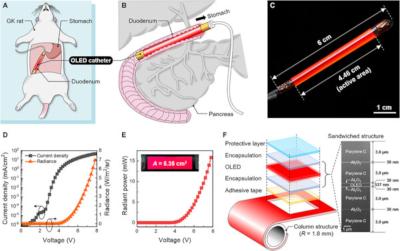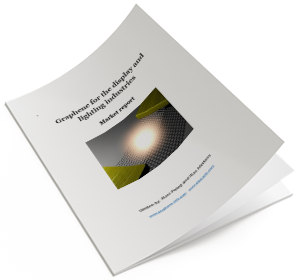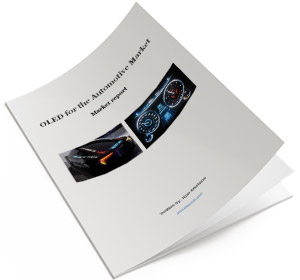OLED (Organic Light Emitting Diodes) are light emitting panels made from organic (carbon based) materials that emit light when electricity is applied. OLED displays are popular today in smartphones, laptops, wearables, TVs, and more - but these panels can also be useful for lighting purposes.
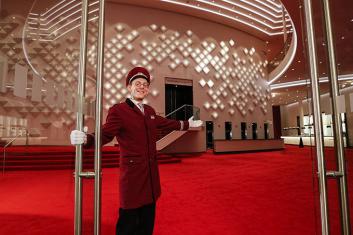
An OLED 'light bulb' is a thin film of material that emits light. OLED is the only technology that can create large "area" lighting panels (as opposed to point or line lighting enabled by LEDs and fluorescent bulbs). OLEDs can be used to make flexible and transparent panels, and can also be color-tunable. OLEDs emit beautiful soft diffused light - in fact OLEDs lighting is the closest light source to natural light (with the exception of the old incandescent lamps).
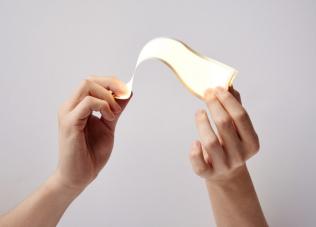
The OLED lighting market
OLED is an amazing technology for lighting - it creates beautiful, efficient and healthy light sources. OLED lighting has great promise but unfortunately the high price of production is a challenge that no one has managed to overcome and OLED lighting remains a small niche industry as of 2024.
In the early years, several large lighting makers (including GE, Philips, OSRAM, LG, Konica Minolta, Panasonic, NEC and others) had active OLED lighting programs, but slowly almost all of these companies dropped out of the market - for various reasons - but the main one being that the large investments in large scale production are not certified to lead to market adoption and the competition with LED lighting is extremely difficult.
But not all is lost. Konica Minolta is now mass producing OLED lighting panels, and OLEDWorks (which took over Philips' OLED lighting fab in Germany) is making excellent progress with automotive OLED lighting. China-based Yeolight is building $100 million OLED lighting fab, and Germany's Inuru is targeting niche markets with its printed OLEDs.
Further reading
- An introduction to OLEDs
- OLED Technology explained
- Transparent OLEDs
- Flexible OLEDs
- The OLED Toolbox, our comprehensive OLED industry information resource
Inuru raises $10 million, to focus on printed OLED lighting for the medication and entertainment sectors
Germany-based OLED lighting developer Inuru announced that it has raised $10 million, from Aper Ventures, Adamed Technology (the venture capital arm of Polish pharmaceutical company Adamed Pharma), ARIA, and a group of business angels. Inuru says that the new funds will enable it expand into new industries with its interactive OLED labels.

Inuru says it is now focusing on two sections: medication and entertainment. Inuru's main focus for the medication industry is to use its OLED labels to assist patients in learning the expiration date on medication and to adhere to the prescribed guidelines. The company says that the repercussions of non-adherence and medication mismanagement contribute to an estimated $600 billion in preventable healthcare expenses and 325,000 annual fatalities.
Yeolight demonstrates new automotive OLED lighting prototypes
China-based Yeolight demonstrated new OLED lighting taillights designs at the Automotive Lighting Exhibition in Shanghai. In the video below you can see some of the various prototypes:
And in the photos below you can see some others. These are interesting prototypes. Some of these have been developed in collaboration with automotive makers, for example Geely-owned Zeekr.
MicroLEDs used to fix and replace an old OLED lighting installation in Taipei
Many years ago, The W Hotel in Taipei installed an OLED installation called You Fade to Light, designed by rAndom International creative studio and powered by Philips' OLED lighting panels. This beautiful piece consists of 2,000 modules, each lighting up as a response to people moving in front of it.
After several years these OLED panels started to fail (and fade, which is rather ironic given the installation's name), and now the hotel replaced the OLED panels with microLED-powered panels. It is said that the microLEDs achieved the same level of uniformity and light output of the OLEDs, maybe even surpassing them.
OLED-Info updates its Automotive OLED Market Report
Today we published a new edition of our Automotive OLED Market Report, with all the latest information. The new edition includes new car models with OLED displays and lighting, and updates from several companies, including LG's new automotive OLED strategy. The adoption of OLED technologies by the automotive is accelerating and expected to continue in the future.
Reading this report, you'll learn all about:
- OLED advantages and challenges
- PMOLED and AMOLED displays adopted in cars today
- Why OLED lighting is exciting for car makers
- All about flexible and transparent OLEDs
The report package also provides:
- A directory of all OLED automotive display makers
- OLED lighting roadmaps
- Personal contact details into leading OLED produces
- Car concepts with OLED technologies
- Free updates for a year
This OLED Automotive market report provides a great introduction to OLED display and lighting solutions for the automotive industry. This is a great guide for anyone involved with the automotive market - car makers, suppliers and aftermarket solutions.
Korean researchers developed the first internal-use OLED-based phototherapy platform
Researchers from the Korean Advanced Institute of Science and Technology (KAIST) and the Asan Medical Center (AMC) have developed the world's first OLED-based catheter for phototherapy within internal organs.
OLED-based light therapy has been researched, and even commercialized, before, but only for external use. This is the first time that such a device has been developed for internal use. The device developed by the joint research team is a catheter-shaped OLED platform that can be directly inserted into tubular organs like the duodenum and is water-resistant.
Audi's 2024 Q8 SUV to sport OLED taillights
Audi has unveiled the 2024 Q8 (and SQ8) SUV, which will sport OLED taillights, similar to the ones used in the 2022 Audi A8. These digital taillight OLEDs are supplied by OLEDWorks.
Audi recently announced that the 2024 Audi Q6 e-tron will come with its its second-gen OLED taillight technology, with 360 individual OLED panels built into 6 different lighting panels. The Q8 will likely use Audi's first-gen design, as it is said to be similar the the 2022 A8. The Q6 e-tron will also sport an AMOLED display in the dashboard.
Yeolight starts installing production equipment at its $300 million 4.5-Gen OLED lighting fab
In May 2022 we reported that China-based OLED lighting developer Yeolight Technology is starting to build a 4.5-Gen OLED lighting production line, in Huaibei City, Anhui Province, China. The company is now starting to move in and install the first production equipment. The total equipment cost is estimated at 800 million Yuan (about $111 million USD).

Yeolight says that the new fab, when complete, will have a capacity of around 7 million panels in a year, or 1.2 million automotive lighting modules (probably referring to rear light modules). This will be the world's largest OLED lighting fab, when complete.
Audi unveils its second-gen OLED lighting taillights, to be adopted in the 2024 Q6 e-tron
Audi unveiled the upcoming 2024 Audi Q6 e-tron, with its second-gen OLED taillight technology. The new taillight lighting system use a total of 360 individual OLED panels built into 6 different lighting panels (each made from 60 OLED panels, or segments as Audi calls them), and is able to show warnings and signals to other drivers. The OLEDs are likely produced by OLEDWorks, like all of Audi's recent OLED panels.
Audi will ship the cars with 8 pre-configured digital light signatures, and customers will be able to add their personal light signatures using the myAudi app.
OLED-Info publishes a new edition of its Graphene for Displays and Lighting Market Report
Today we published a new edition of our Graphene for Displays and Lighting Market Report, with all the latest information. Graphene has high potential to improve OLED and MicroLED displays and can be used to enhance displays backplanes, electrodes, emitters and more. In addition graphene can increase efficiency in OLED lighting devices and improve designs.
Reading this report, you'll learn all about:
- Graphene applications in LED and OLED lighting
- Graphene's adoption as a backplane for AMOLEDs
- Transparent graphene electrodes
- Graphene-based encapsulation development
The report package also provides:
- Graphene companies involved with display and lighting
- An introduction to graphene
- An introduction to lighting and displays
- Details about graphene for QDs, lasers and thermal foils
This market report provides a great introduction to graphene solutions for the display and lighting markets, and covers everything you need to know about graphene technologies in these niches. This is a great guide for anyone involved with the displays and lighting.
A new version of OLED-Info's Automotive OLED Market report released
Today we published a new edition of our Automotive OLED Market Report, with all the latest information. The new edition includes three new car models, updates from Samsung, JDI and JOLED, new market forecasts and more. The adoption of OLED technologies by the automotive is accelerating and expected to continue in the future.
Reading this report, you'll learn all about:
- OLED advantages and challenges
- PMOLED and AMOLED displays adopted in cars today
- Why OLED lighting is exciting for car makers
- All about flexible and transparent OLEDs
The report package also provides:
- A directory of all OLED automotive display makers
- OLED lighting roadmaps
- Personal contact details into leading OLED produces
- Car concepts with OLED technologies
- Free updates for a year
This OLED Automotive market report provides a great introduction to OLED display and lighting solutions for the automotive industry. This is a great guide for anyone involved with the automotive market - car makers, suppliers and aftermarket solutions.
Pagination
- Previous page
- Page 2
- Next page



